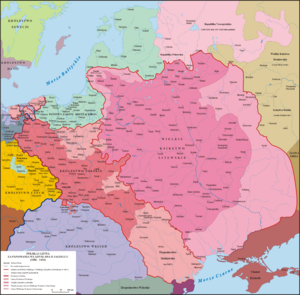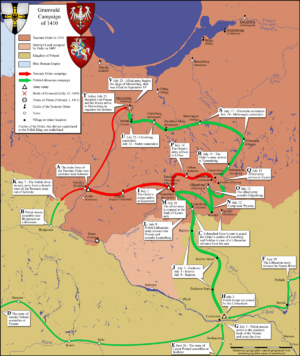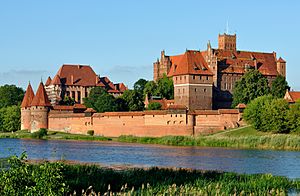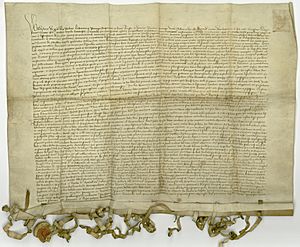Polish–Lithuanian–Teutonic War facts for kids
Quick facts for kids Polish–Lithuanian–Teutonic War |
|||||||
|---|---|---|---|---|---|---|---|
| Part of Northern Crusades and Lithuanian Crusade | |||||||
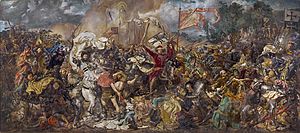 Battle of Grunwald by Jan Matejko (1878) |
|||||||
|
|||||||
| Belligerents | |||||||
|
Allies: |
Allies: |
||||||
| Commanders and leaders | |||||||
The Polish–Lithuanian–Teutonic War, also known as the Great War, happened between 1409 and 1411. It was fought between the Teutonic Knights and the combined forces of the Kingdom of Poland and the Grand Duchy of Lithuania.
The war started because of a local uprising in Samogitia. The Teutonic Knights invaded Poland in August 1409. Neither side was fully ready for a big war. So, Wenceslaus IV of Bohemia helped arrange a nine-month break in the fighting.
After this break ended in June 1410, the Teutonic Knights faced a huge defeat. This happened at the Battle of Grunwald, one of the biggest battles in medieval Europe. Many leaders of the Teutonic Knights were killed or captured.
Even though they lost the battle, the Knights managed to defend their capital city, Marienburg (Malbork). They lost only a small amount of land in the Peace of Thorn (1411) treaty. Land disagreements continued until the Peace of Melno in 1422.
However, the Knights never got back their old strength. The huge cost of paying for the war led to problems within their lands. This war changed the power balance in Central Europe. It also showed that the Polish–Lithuanian union was becoming a very strong power.
Contents
Why the War Started: A Look Back
In 1230, the Teutonic Knights moved to an area called Kulmerland. They were a military order, which means they were like soldier-monks. They were asked by Konrad I, a Polish duke, to fight against the pagan Prussian clans. This was called the Prussian Crusade.
With support from the Pope and the Holy Roman Emperor, the Teutons conquered the Prussians by the 1280s. They then turned their attention to the Grand Duchy of Lithuania, who were also pagan. For about 100 years, the Knights fought in the Lithuanian Crusade. They often raided Lithuanian lands, especially Samogitia. This area was important because it separated the Knights in Prussia from their other group in Livonia.
The fighting made the border regions empty. But the Knights did not gain much land. The Lithuanians first gave up Samogitia in 1381-84 during a civil war. They used the land as a way to get the Teutonic Knights to support one side in their internal power struggles.
A New Alliance and Changing Times
In 1385, Grand Duke Jogaila of Lithuania decided to marry Queen Jadwiga of Poland. This created a personal union between Poland and Lithuania, meaning they shared the same ruler. Jogaila became Christian and was crowned King of Poland.
Lithuania officially became Christian. This meant the Teutonic Knights no longer had a religious reason to fight them. However, the Knights said that Jogaila's conversion was not real. They took their case to the Pope.
Disputes over land continued, especially about Samogitia. The Knights had controlled Samogitia since 1404. Poland also had claims against the Knights in Dobrzyń Land and Danzig (Gdańsk). But generally, Poland and the Knights had been peaceful since 1343.
The conflict was also about trade. The Knights controlled the lower parts of three big rivers: the Neman, Vistula, and Daugava. These rivers were important for trade in Poland and Lithuania.
The War Begins
Uprising, War, and a Short Break
In May 1409, an uprising began in Samogitia, which the Teutonic Knights controlled. Lithuania supported this uprising. The Knights then threatened to invade Lithuania. In response, Poland said it would support Lithuania and threatened to invade Prussia.
As the Knights' troops left Samogitia, their Grand Master, Ulrich von Jungingen, declared war. This happened on August 6, 1409. The Knights hoped to defeat Poland and Lithuania one by one. They started by invading Greater Poland and Kuyavia, surprising the Poles.
The Knights burned a castle, captured a town, and took over Bydgoszcz. They also attacked several other towns. The Poles fought back and took Bydgoszcz back. The Samogitians also attacked Memel (Klaipėda). But neither side was ready for a full-scale war yet.
Wenceslaus, King of the Romans, offered to help settle the argument. A truce was signed on October 8, 1409. It was set to end on June 24, 1410. Both sides used this time to get ready for a big battle. They gathered troops and tried to make deals with other countries.
Both sides sent letters and messengers. They accused each other of bad deeds and threats to Christianity. Wenceslaus received a gift of 60,000 florins from the Knights. He then said that Samogitia belonged to the Knights. He also said that only Dobrzyń Land should go back to Poland.
The Knights also paid 300,000 ducats to Sigismund of Hungary. Sigismund wanted to control Moldova. He tried to break the Polish–Lithuanian alliance. He offered Vytautas a king's crown. If Vytautas accepted, it would go against an agreement with Poland. This would cause problems between Poland and Lithuania. At the same time, Vytautas managed to get a truce from the Livonian Order.
Planning the Attack and Marching to War
By December 1409, King Jogaila and Grand Duke Vytautas had a plan. Their armies would join together. They would march as one huge force towards Marienburg (Malbork). Marienburg was the capital of the Teutonic Knights.
The Knights were ready to defend. But they did not expect a combined attack. They thought Poland would attack along the Vistula River towards Danzig. They also thought Lithuania would attack along the Neman River towards Ragnit. To prepare for this, Ulrich von Jungingen gathered his forces in Schwetz (Świecie). This was a central place where troops could quickly respond to any invasion.
To keep their real plan a secret, Jogaila and Vytautas made several small raids. These raids were into border areas. This made the Knights keep their troops in place, thinking they knew the plan.
The first step of the Grunwald campaign was to gather all Polish–Lithuanian troops. They met at Czerwinsk, about 80 km from the Prussian border. There, the combined army crossed the Vistula River using a special pontoon bridge. This was a difficult move. It needed careful planning and teamwork among soldiers from many different groups. It took about a week, from June 24 to 30, 1410.
After crossing the river, troops from Masovia joined the army. These were led by Siemowit IV and Janusz I. The huge army then began marching north towards Marienburg (Malbork) on July 3. They crossed into Prussia on July 9.
When Ulrich von Jungingen finally understood the Polish–Lithuanian plan, he acted quickly. He left 3,000 men at Schwetz (Świecie) under Heinrich von Plauen. He then moved his main forces to set up a defense line. This was along the Drewenz River (Drwęca) near Kauernik (Kurzętnik).
On July 11, Jogaila decided not to cross the river there. It was a very strong defensive spot for the Knights. Instead, the army turned east. They went towards the river's source. This way, no other big rivers would block their path to Marienburg. The Teutonic army followed the Drewenz River north. They crossed it near Löbau (Lubawa). Then they moved east, marching parallel to the Polish–Lithuanian army. The Polish-Lithuanian army destroyed the village of Gilgenburg (Dąbrówno). Von Jungingen was so angry that he swore to defeat the invaders in battle.
The Great Battle of Grunwald
The Battle of Grunwald happened on July 15, 1410. It took place near the villages of Grunwald, Tannenberg (Stębark), and Ludwigsdorf (Łodwigowo). Experts today believe there were between 16,500 and 39,000 Polish–Lithuanian soldiers. The Teutonic side had between 11,000 and 27,000 men.
The Polish–Lithuanian army was a mix of many different groups and religions. Roman Catholic Polish–Lithuanian troops fought alongside pagan Samogitians, Eastern Orthodox Ruthenians, and Muslim Tatars. On the Teutonic side, there were soldiers from 22 different groups, mostly Germanic.
The Knights hoped to make the Poles or Lithuanians attack first. They even sent two swords, known as Grunwald Swords, to "help Jogaila and Vytautas in battle." The Lithuanians attacked first. After more than an hour of hard fighting, the Lithuanian light cavalry began to retreat. It is still debated whether this was a real retreat or a planned move.
Heavy fighting then started between the Polish and Teutonic forces. The battle even reached King Jogaila's camp. One Knight charged directly at King Jogaila. He was saved by his royal secretary, Zbigniew Oleśnicki. The Lithuanians then returned to the battle. As Grand Master von Jungingen tried to break through the Lithuanian lines, he was killed.
With their leader dead and surrounded, the Teutonic Knights began to retreat. They headed towards their camp, hoping to set up a defensive wagon fort. But their defense was quickly broken. The camp was destroyed. One person who saw the battle said that more Knights died there than on the battlefield itself.
The defeat of the Teutonic Knights was huge. About 8,000 Teuton soldiers were killed. Another 14,000 were taken prisoner. Most of the Order's brothers were killed, including many of their leaders. The highest-ranking Teutonic official to escape was Werner von Tettinger.
Most of the captured common soldiers and mercenaries were set free soon after the battle. They just had to promise to report to Kraków on November 11, 1410. The nobles were kept captive. High ransoms were demanded for each of them.
The Siege of Marienburg Castle
After the battle, the Polish and Lithuanian armies waited to attack the Teutonic capital, Marienburg (Malbork). They stayed on the battlefield for three days. Then they marched slowly, only about 15 km each day. The main forces did not reach the very strong Marienburg until July 26.
This delay gave Heinrich von Plauen enough time to get the castle ready for defense. Some historians think King Jagiełło might have delayed on purpose. He and Vytautas might have wanted to keep the Order weakened but not completely destroyed. This would keep the balance of power between Poland and Lithuania. If the Order was totally defeated, Poland would likely get most of its lands. But there are no clear records to prove this.
Meanwhile, Jogaila also sent his troops to other Teutonic fortresses. Many of these castles surrendered without a fight. This included important cities like Danzig (Gdańsk), Thorn (Toruń), and Elbing (Elbląg). Only eight castles remained in Teutonic hands.
The Polish and Lithuanian armies besieging Marienburg were not ready for a long siege. They ran out of ammunition. Their soldiers lost hope, and many got sick with dysentery. The Knights asked their allies for help. Sigismund of Hungary, Wenceslaus, King of the Romans, and the Livonian Order promised money and more soldiers.
The siege of Marienburg was stopped on September 19. The Polish–Lithuanian forces left soldiers in the castles they had captured or that had surrendered. Then they went home. However, the Knights quickly took back most of their castles. By the end of October, only four Teutonic castles near the border were still held by Poland.
Jogaila gathered a new army. He defeated the Knights again in the Battle of Koronowo on October 10, 1410. After a few more small fights, both sides agreed to talk about peace.
What Happened After the War
The Peace of Thorn was signed on February 1, 1411. Under this agreement, the Knights gave the Dobrin Land (Dobrzyń Land) to Poland. They also agreed to give up their claims to Samogitia. This would last for the lifetimes of King Jogaila and Grand Duke Vytautas.
However, two more wars would be fought later. These were the Hunger War of 1414 and the Gollub War of 1422. Finally, the Treaty of Melno permanently settled the land disputes.
Poland and Lithuania did not gain much land or diplomatic power from their military victory. But the Peace of Thorn put a huge financial burden on the Knights. They never fully recovered from it. They had to pay a large amount of silver. This amount was estimated to be ten times the yearly income of the King of England. They had to pay it in four yearly payments.
To make these payments, the Knights borrowed a lot of money. They also took gold and silver from churches. And they raised taxes. Two major Prussian cities, Danzig (Gdańsk) and Thorn (Toruń), protested against the higher taxes.
The defeat at Grunwald left the Teutonic Knights with few soldiers to defend their lands. Since both Poland and Lithuania were now Christian, the Knights found it hard to get new volunteer crusaders. The Grand Masters then had to hire mercenary troops. These paid soldiers were very expensive and drained their already low budget.
The internal problems, money troubles, and higher taxes led to unrest. This led to the creation of the Prussian Confederation in 1441. This group was an "Alliance against Lordship." It then led to a series of conflicts. These ended in the Thirteen Years' War (1454).
See also
 In Spanish: Guerra polaco-lituano-teutónica para niños
In Spanish: Guerra polaco-lituano-teutónica para niños


